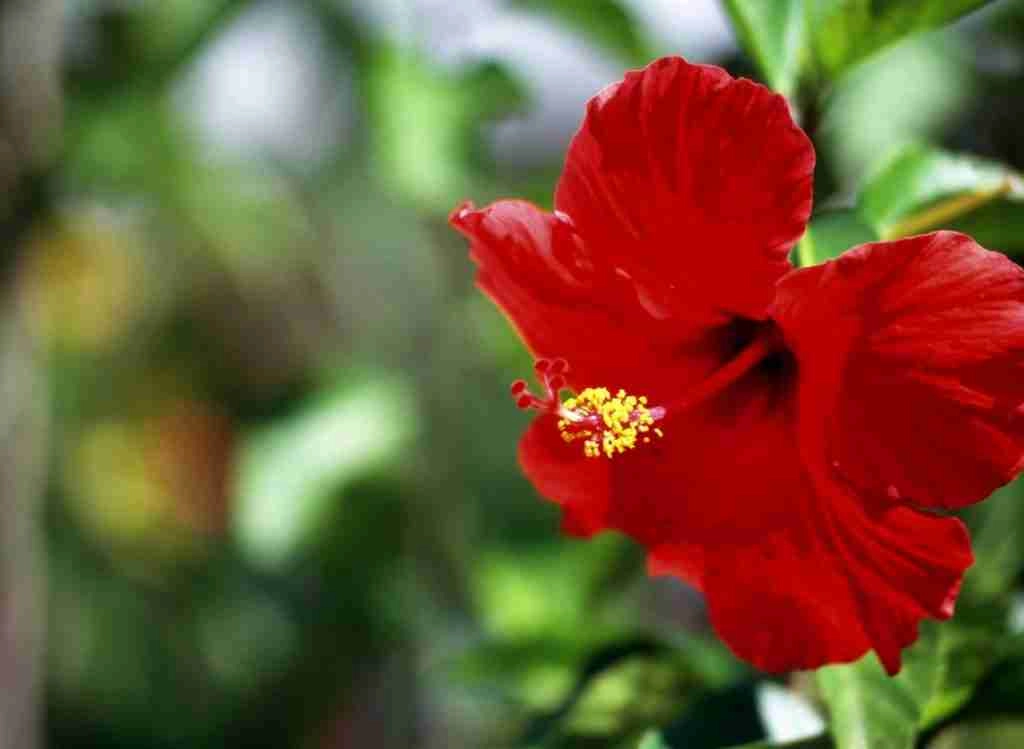
Hibiscus plants thrive in areas with full sun and regular amounts of water. You can also grow them in containers, houseplants, raised beds, landscapes, and hanging baskets. Even with minimum care, hibiscus plants offer great rewards throughout the year, including adding color to your garden.
However, like any living creature, hibiscus plants face disease, and in this article, we discuss the five hibiscus plant diseases to look out for and how to prevent or treat them.
See also: 5 Of The Best Companion Plants For Your Olive Trees To Know Abou
Is Hibiscus a Plant Or a Tree?
Hibiscus (genus Hibiscus) is a genus of numerous herbs, shrubs, and trees in the mallow family (Malvaceae), generally divided into four groups: hardy hibiscus, Rose of Sharon, tropical hibiscus, and all the various species of hibiscus.
In addition, hibiscus plants produce large, colorful, trumpet-shaped flowers throughout a long season.
Here is a snapshot of the main characteristics of hibiscus plants.
| Genus name | Hibiscus |
| Plant family | Malvaceae |
| Sun exposure | Full sun |
| Plant type | Trees, shrubs, perennials, and annuals |
| Hardiness USDA Zones | – Hardy perennial hibiscus dies down in cold temperatures, including red hibiscus (Hibiscus coccineus) will grow well in zones 5 to 9. – Tropical hibiscus (Hibiscus rosa-Sinensis) is an evergreen blooming essentially year-round and grows in zones 9 and 10. |
| Temperature | – Ideal is between 65° to 75°F – The hibiscus plants do not tolerate cold temperatures; they need warm temperatures for flowers to thrive. |
| Height | A height of 4.5 meters (15 feet) rarely exceeds 2 meters (6.5 feet). |
| Blossoms Main Colors | – White – Yellow – Red – Pink – Lavender – Burgundy |
| Blooming Seasons | – Hibiscus flowers are beautiful; however, they are short-lived, generally in bloom for only one day. – Perennial hibiscus blooms in mid to late summer. |
| Soil Type | A rich and well-drained soil mix is perfect for growing hibiscus. |
| Watering Requirements | – Water your hibiscus plants from the top of the soil down so that water runs out the bottom holes. – And ensure you keep the soil moderately moist, not too saturated. |
| Fertilizer | Hibiscus plants are heavy feeders and need a balanced fertilizer, including 10-10-10 or 20-20-20. |
| Maintenance requirements | Overwatering or overfertilizing can increase the possibility of many hibiscus plant diseases. |
| Propagation | Vegetative cuttings or seeds |
5 Hibiscus Plant Diseases To Look Out For!
Below are the 5 Hibiscus plant diseases you need to look out for.
1- Leaf spots
Fungal leaf spots (AKA black spots) are ugly spots appearing on the upper surface of leaves of ornamentals and shade trees; however, they do not harm the plant most of the time.
Black spot is a fungus that often attacks hibiscus plants when you leave them in wet conditions. Symptoms of black spots include black and brown spots on leaves. In addition, the leaves may eventually begin to yellow and fall off.
A variety of fungal pathogens cause the majority of the leaf spots, but bacteria cause some. Generally, leaf spot diseases weaken shrubs and trees by preventing photosynthesis, reducing growth, and increasing your hibiscus plant’s sensitivity to pests and other diseases.
See also: Can Tomatoes Really Grow In Indirect Sunlight: Here’s The Truth!
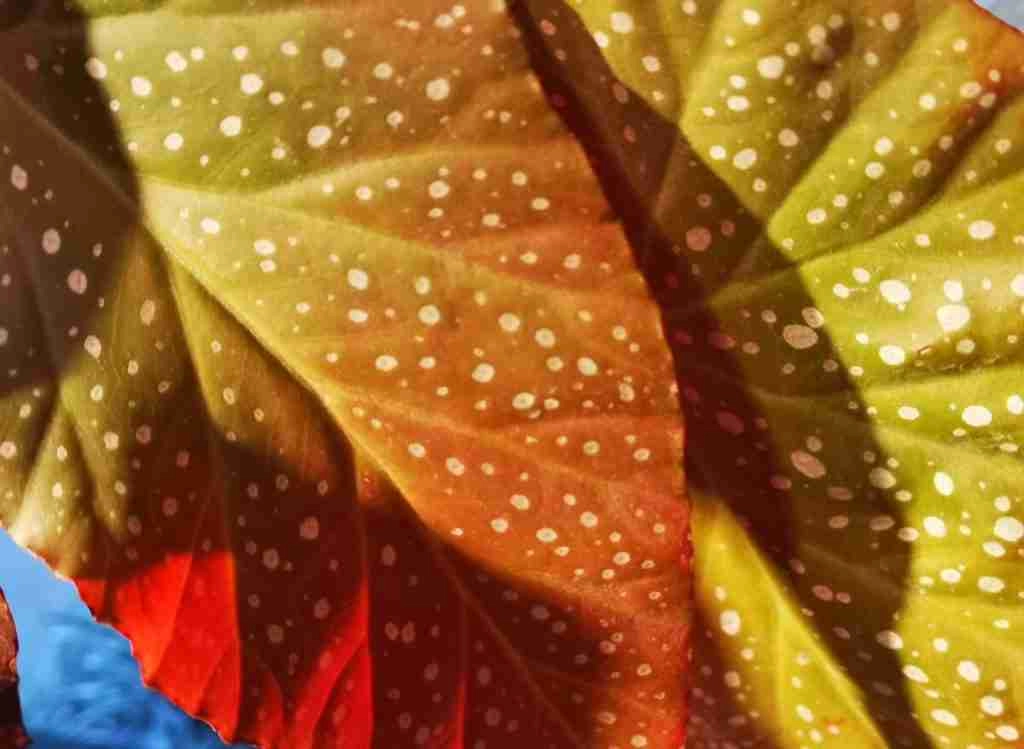
Life Cycle
Most leaf spot fungi have the same life cycle. In general, cool, wet weather early in the growing season encourage the leaf spot fungi, and they are rarely an issue during or after warm, dry weather in the spring.
In the spring, throughout or following a rain, spores produced by the fungus are released and carried by the wind and spattering rain to newly emerging leaves. The spore develops and penetrates these tender young leaves causing infection.
Small spots will appear on the leaves in a few days to several weeks, depending on temperature. As the fungus grows, the spots increase. The fungus in the spots may produce even more spores, causing secondary infections on other leaves.
How To Treat Leaf spots
Generally, leaf spot diseases will not seriously harm your plants, but there are things you can do that when done together, can help you prevent leaf spots from showing on your hibiscus plant in the following years.
- Rake up and destroy fallen leaves before winter (or first snowfall) to eliminate areas where diseases can survive and re-infect the plant the following season.
- Do not overcrowd plants.
- Prune trees or shrubs to improve light penetration and promote air circulation throughout the canopy.
- Moist conditions promote disease, so water trees at the base and not splash water on leaves.
- Using a drip or soaker hose works best for this, and try to avoid using sprinklers.
- Water your tree during the growing season to moisten the soil’s top 6 to 8 inches, especially during dry summer.
- Maintain a 3- to 4-inch (7.62 cm to 10.16) -deep layer of mulch around your hibiscus plant (Annually reapply mulch)
- Avoid fertilizing trees and shrubs suffering from leaf spot diseases unless a soil test is suggested to correct a nutrient deficiency.
- It is unnecessary to apply fungicides unless your hibiscus plant has lost all of its leaves several years in a row.
- Generally, hibiscus plants tolerate leaf spots with little to no harm unless they are unhealthy.
- To prevent the fungus from spreading, you should remove and destroy fallen leaves as soon as possible, suggests the University of California IPM Online.
2- Botrytis
Botrytis (Botrytis cinerea), commonly called blight, affects hibiscuses’ buds, causing them to turn brown and ultimately drop off before they even open.
Like leaf spots, botrytis thrives in humid weather, cool, particularly during the spring and fall. When conditions are hot and dry, it rarely occurs on outdoor hibiscuses.
Here is the first report of botrytis blight, caused by botrytis cinerea, on hibiscus in South Africa.

The fungus can attack and damage almost any plant part but prefers tender tissues, including petals and buds, or weakened or injured tissues, such as wounds and aging or dying plant tissue.
How To Treat Botrytis
Keeping your growing area clean is the way to prevent botrytis because botrytis can form multiple spores in a very short time under favorable conditions.
- Ensure your hibiscus plant growing area is clear of diseased plants.
- Remove affected canes, blooms, or stems.
- Bag and destroy diseased plant parts to decrease inoculum.
- Do not place them in a compost or trash pile near roses.
- Water carefully to reduce excessive humidity and wetness on the plants.
- Space hibiscus plants, so they have good air circulation.
- When pruning, avoid unnecessary wounding of the plants because these wounds create entry sites for the fungus to infect the plant.
- Promote good air circulation and light penetration with proper pruning and controlling the weed.
- Prevent wounding your hibiscus plant by controlling insects, birds, and other grape diseases.
- Sanitation is the first essential step.
- Remove dead or dying tissue from the hibiscus plants and the soil surface.
- Do not throw debris under benches or on walks. Sanitation alone is not enough to control this fungus. The fungus can produce about 60,000 or more spores on a piece of plant tissue the size of your small fingernail. Even one spore can infect a plant and cause disease.
- Avoid injuring plants in any way.
- Heat and ventilate greenhouses to prevent high humidity conditions.
3- Hibiscus Root Rots (AKA Phytophthora)
Almost all nut trees and fruit and most ornamental trees and shrubs, including hibiscus plants, can develop Phytophthora rot (or root rots) if the soil around the base of the hibiscus plant remains wet for more extended periods or when planted too deeply.
Initially, Phytophthora kills fine roots, slowly progressing towards larger diameter roots and ultimately to the crown at the base of the hibiscus plant. In addition, hibiscus plants pull up quickly from the soil due to root loss.
You can prevent losses to Phytophthora by providing your hibiscus plant with good soil drainage since, generally, Phytophthora requires warm, moist soils to cause disease.
See also: Pros and cons of Miracle grow You Need To Know About
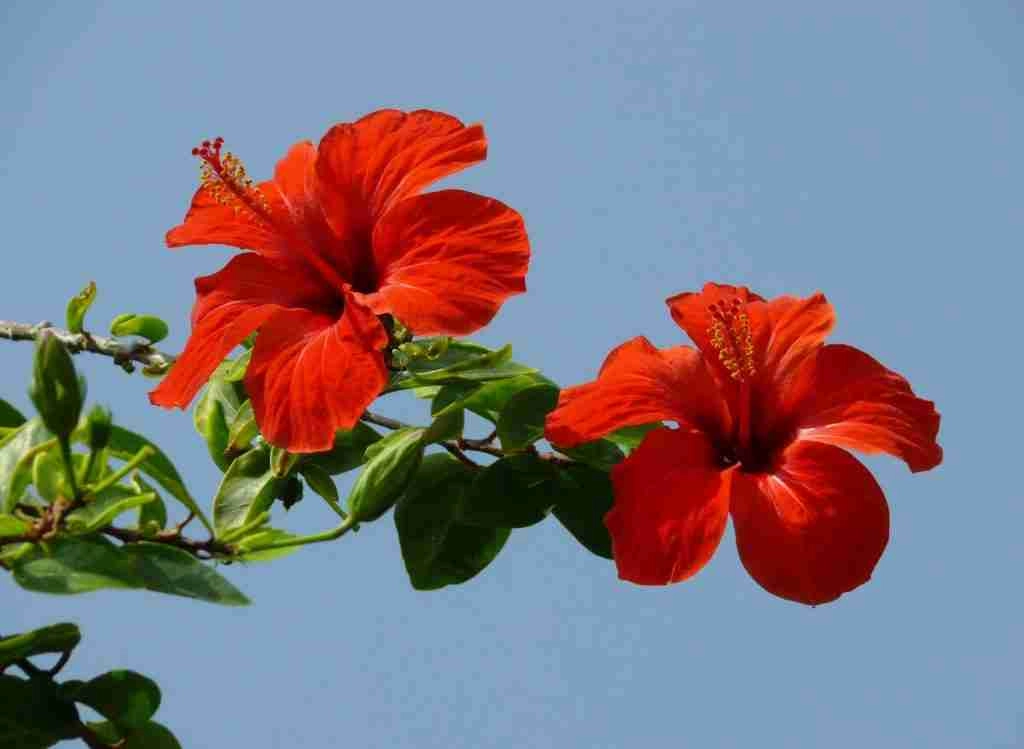
Life Cycle
Phytophthora rot is a soilborne water mold that can quickly spread from an infested field to a new area through the movement of water in the soil or on the surface, according to the Pennsylvania State University Extension.
New infections can appear when the temperatures exceed 59°F (15°C). Resting spores that can survive for several years in the soil or plant are formed throughout cold and dry periods.
When favorable temperature and moisture conditions are present, these resting spores will grow and form another type of spore-producing structure called sporangia. When they contact susceptible tissue, they germinate and penetrate the roots, form mycelium, and cause infection.
Hibiscus Root Rots Symptoms
Generally, symptoms for Phytophthora rots include root rot, stem and crown rot, stunting, yellowing, and wilting. However, plants with low levels of infection may not have noticeable symptoms.
How To Treat Phytophthora Rots
- Good water management is the most critical factor in reducing the threat of Phytophthora.
- Avoid prolonged soaking of the soil or standing water around the base of your hibiscus plant.
- Water only as much and as often as needed; if you irrigate your hibiscus plant with sprinklers, try to use low-angle sprinkler heads and splitters to prevent wetting the trunk and lower branches. If using a drip system, put the emitters at least a foot away from the trunk.
- During favorable weather conditions, do not let the roots and crown of your hibiscus plants to remain wet for 4 to 8 hours required for Phytophthora to infect the plant.
- Clean gardening tools after working with phytophthora rot-infected plants
- Use raised beds to improve drainage for plants in well-drained fields
- If possible, prepare your growing site properly before planting the hibiscus plants by removing all roots of previous plants from the area, improving the drainage.
See also: 5 Of The Best Companion Plants For Your Lantana Plants To Know About!
4- Myrothecium Roridum
Myrothecium roridum is a soil-borne pathogen that periodically causes a crown, stem rot, or even a leaf spot.
In addition, Myrothecium roridum can also cause disease symptoms in lantanas, begonias, petunias, and verbenas.
See also: How To Easily And Successfully Get Rid Of Golden Rain Tree Bugs: A Complete Guide
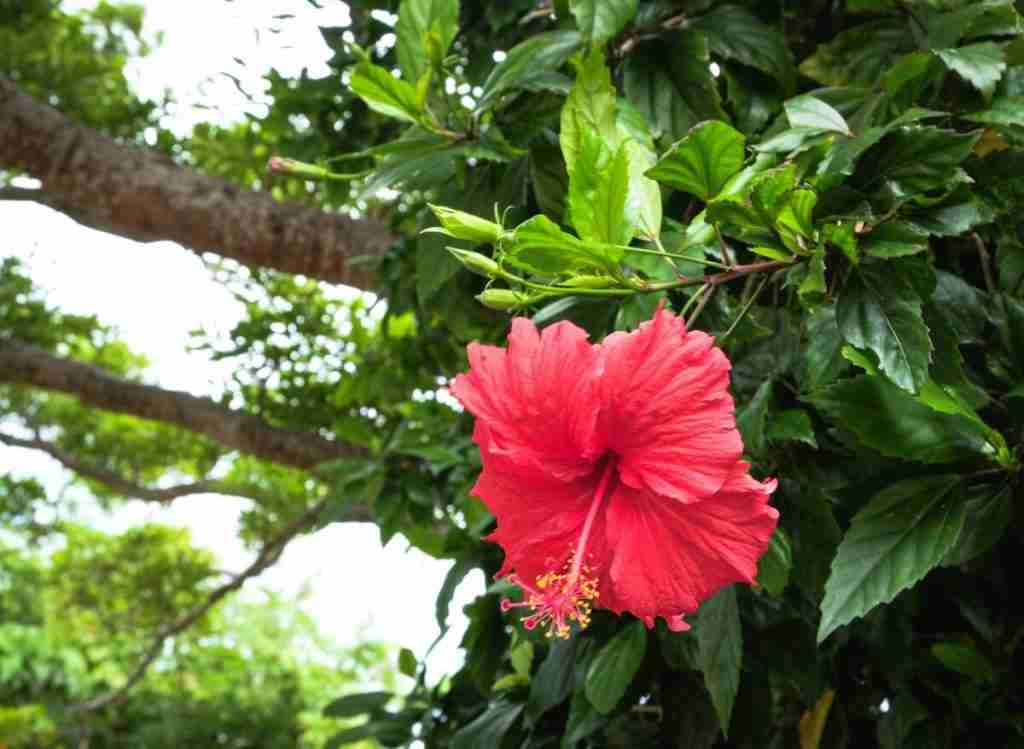
Myrothecium Roridum Symptoms
Symptoms of myrothecium roridum may include new growth dying, leaves failing to develop, and necrotic tissue. It can spread by gardening tools, infected plants, insects, seeds, and hands and shoes.
You can prevent myrothecium roridum by providing good airflow, keeping your plants well-fed, healthy, and having good plant and personal hygiene.
How To Treat Myrothecium Roridum
- Avoid injuries to hibiscus plants because young or injured tissue is most susceptible.
- Avoid excessive fertilization. High fertilizer rates may promote Myrothecium Roridum.
- Reduce periods of leaf wetness through careful timing of irrigation.
- You may need to apply Fungicide to control severe disease problems.
5- Pests
Common, the most harmful insects to your hibiscus plant are aphids and spider mites. Ensure you keep a good eye on your hibiscus plant to prevent insect problems before they become severe and damage your plant.
If necessary, you can control insect pests on hibiscus with insecticidal soap or insecticides designated for use on hibiscus.
See also: How To Easily And Successfully Remove Aphids From Kale: A Quick Guide
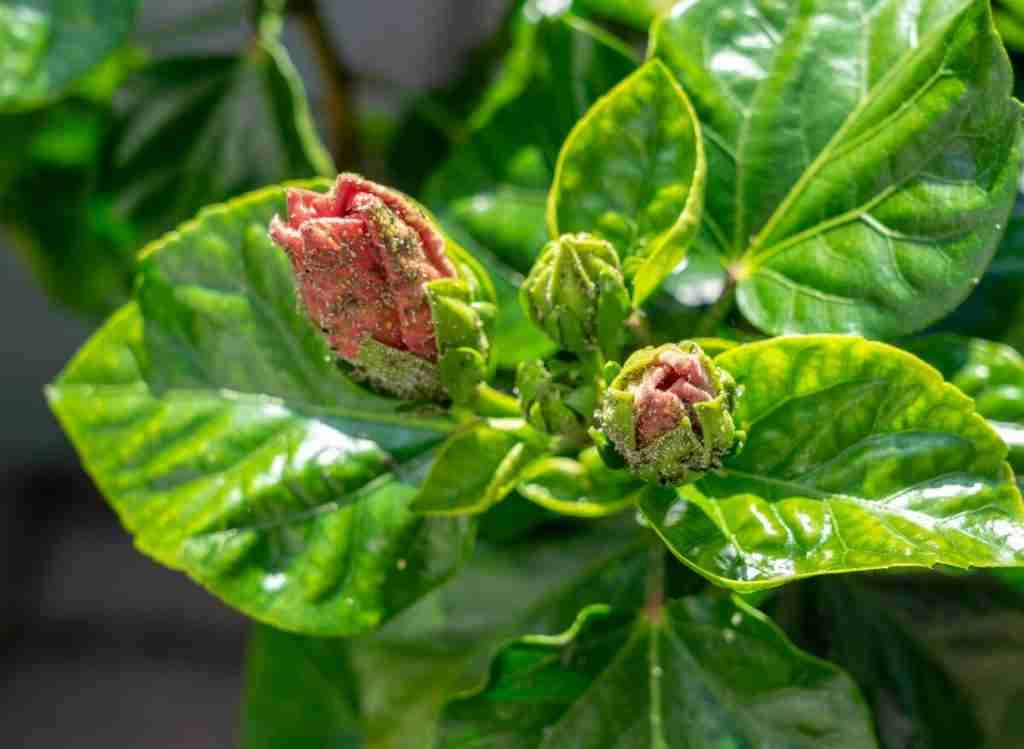
Be careful if you decide to use a chemical pesticide. While you might kill the harmful pest, you could also kill beneficial insects such as honey bees and other beneficial bugs.
See also: How To Effectively Use Nematodes To Control Garden Pests!
Common Harmful Pest For Hibiscus Plants
| Insect | Symptoms |
| Aphids | The appearance of sooty mold on your hibiscus plants can be a sign of an aphid infestation. The drops can attract other insects, including ants, flies, and wasps, to feed sticky deposits. |
| Japanese beetles | Generally, a single beetle does not eat much; however, the presence of many beetles causes severe damage. Adult beetles feed on the upper surface of foliage, chewing out tissue between the veins, which will give the leaf a characteristic skeletonized appearance. |
| Thrips | Thrips are tiny, elongated insects that feed by perforating the outer skin of the leaf and sucking out the fleshy leaf tissue causing off-colored foliage and stunted growth. |
| Spider mites | Spider mites exert piercing-sucking mouthparts to feed on the sap on the underside of leaves and needles, producing tiny white or yellow spots and giving leaves and needles a stippled or mottled appearance. Most gardeners confuse these symptoms with drought stress. Severely infected plants can be damaged and can even cause plants to die, according to the University of Minnesota Extension. |
| San Jose scale | According to the University of Kentucky Department of Entomology, the San Jose scale is one of the most devastating scale species. They kill infested stems, twigs, or branches. First crawlers are generally active from late May to early June; then, a second generation appears in late July, and finally, a third in late summer or early fall. |
| Whiteflies | Cause a white mess on leaves or white-colored flies near the plant. |
| Mealybugs | Sign of bright white, small, cottony spots on the plant’s leaves. |
| Twig pruners | Twig pruners are the larvae of tiny beetles that tunnel in twigs and small branches. You can reduce infestations by collecting and destroying fallen twigs. |
| Phylloxera galls | Phylloxera galls distort leaf growth and cause premature leaf drop, but sometimes the damage is only cosmetic. You can reduce infestations by spraying dormant oil during the winter. |
How to Get Rid of Insect Pests on a Hibiscus Plant
Using insecticidal soap is an effective way to treat common insect pests on hibiscus plants, according to the University of Minnesota Extension.
How To Make Insecticidal Soap:
- Begin with a gallon of bottled or distilled water performs better than tap water, often containing minerals that make insecticidal soap less efficient.
- Add about two and a half to 5 tablespoons of mild liquid dish soap or hand soap to the water.
- Mix the water and soap in a garden sprayer
See also: Best Gardening Tools – You Need to Start a Garden!
How to Apply Insecticidal Soap
- Spray both the heads and bottoms of the hibiscus plant’s leaves liberally with insecticidal soap.
- The best time to spray the insecticidal soap is either early in the morning or late in the afternoon.
- The insects must contact the insecticidal soap directly, so make sure you look for and target the pests when applying the solution.
- Apply every day for a week or so to make sure that you exterminate new hatching insects.
- Repeat the insecticidal application soap every four to seven days until you no longer see any insect pests on your hibiscus plants.
- Keep foliage cleaned by washing periodically.
Final Thoughts
Overall, growing hibiscus plants can be an excellent addition to your garden. It has minimum maintenance requirements and will add color to your garden or landscape and turn it into a beautiful space.
Watch out for these five hibiscus plant diseases that can be very harmful to your plants. And once you notice any signs of the hibiscus plant disease, first ensure it is the right disease and apply the recommended treatment for a healthier, stronger, and more beautiful hibiscus plant and garden.


